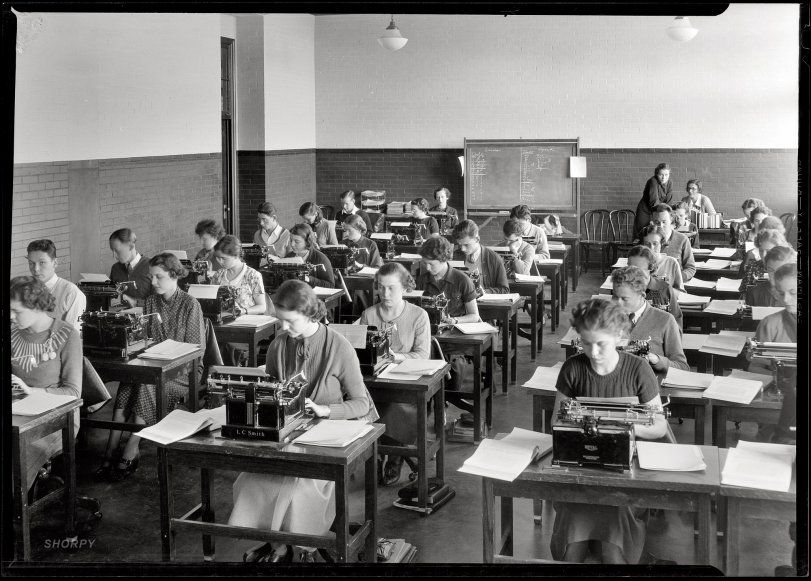


Framed or unframed, desk size to sofa size, printed by us in Arizona and Alabama since 2007. Explore now.
Shorpy is funded by you. Patreon contributors get an ad-free experience.
Learn more.

- Texas Flyer wanted
- Just a Year Too Soon
- WWII -- Replacing men with women at the railroad crossing.
- Yes, Icing
- You kids drive me nuts!
- NOT An Easy Job
- I wonder
- Just add window boxes
- Icing Platform?
- Indiana Harbor Belt abides
- Freezing haze
- Corrections (for those who care)
- C&NW at Nelson
- Fallen Flags
- A dangerous job made worse
- Water Stop
- Passenger trains have right of way over freights?
- Coal
- Never ceases to amaze me.
- Still chuggin' (in model form)
- Great shot
- Westerly Breeze
- For the men, a trapeze
- Tickled
- Sense of loneliness ...
- 2 cents
- Charm City
- What an Outrage
- Brighton Park
- Catenary Supports
Print Emporium
Carbon Copies: 1935

"Bethesda, Maryland. Chevy Chase School, 1935." We backspace to another typing class. National Photo Company Collection safety negative. View full size.
Another silly observation
It looks like each row of desks has a particular brand of typewriter, with all five of the major manufacturers covered. Along with the Royals, L.C. Smiths, and Remingtons in the center of the photo, I spy Woodstocks on the far left and what I believe are Underwoods on the right. I bet the teachers had the students change rows at intervals to allow them to get the feel of each kind of machine.
(Somewhat related: I've sat in front of a few of those, and my favorite is the Royal.)
The More Things Change....
The more things change, the more they stay the same. We had about the same boy-girl ratio in typing class when I took it in 1981 and 1982. Personal computers were just coming on the scene and typing (we'd never heard of "keyboarding") skills were still seen as being of little use for males.
We had a 50-50 mix of manual and electrics and we'd all switch every six weeks. It made for some comical moments. People used to the manuals found just resting their hands on the keyboard of the electric would send that little speedball flying across the platen. And people coming from the electrics would hit the keys and often find that they hadn't hit it quite hard enough, or they had managed to jam the keys together.
I miss the manuals. It was sort of nice to "bounce" on the keys a bit while thinking. And there was something very satisfying about reaching up and whacking the carriage return lever. I've often wished someone would make a modern keyboard that instead of an ENTER key had a good old-fashioned manual typewriter carriage return lever to slap.
Not Silly
I typed so long on manuals that my forearm muscles were the strongest and biggest except for my leg muscles. Sort of Popeye style. Flinging that carriage back every few seconds really helped. Good training -- with no mistakes allowed and 5 carbons, you learned to get it right the first time. I can still do 100 wpm.
Silly observation
Wonderful photos. Funny, Its difficult to find fat people in old photos, everybody looks slim and healthy... Today it seem impossible to take a pic in any academy or school without fat people in it..
Manual typewriters
My mom was a legal secretary in the late '50s/early '60s and spent a lot of time on manual typewriters. To this day, she wears out computer keyboards astonishingly fast and I've always assumed it must be because her "touch" is so strong.
70 wpm
My mother learned to type at about this time. She worked as a secretary for many years and I still marvel when remembering her typing at about 60 to 70 words a minute on one of those monsters. Although she would agree with A. Tipster about the Selectric.
Weekend Update
Hi. We're Chevy Chase students ... and you're not!
Underwood Memories
The mix of machines (Royal, L.C. Smith and Underwood) reminds me of my first typewriter, a 1945 Underwood that weighed as much as a car battery. Although I never had formal training I could go pretty fast, only to find I could type even faster on an IBM Selectric III, the greatest typewriter ever made. A lot of a typist's time with the old manuals was spent pushing the keys that long way down to raise the typebar to strike the ribbon. With the Selectric, the key travel was maybe a quarter of the manual and I could make that "golf ball" typing element fly down the line. I'm using a NOS IBM PS/2 keyboard now, very similar to the Selectric of yore.
























On Shorpy:
Today’s Top 5